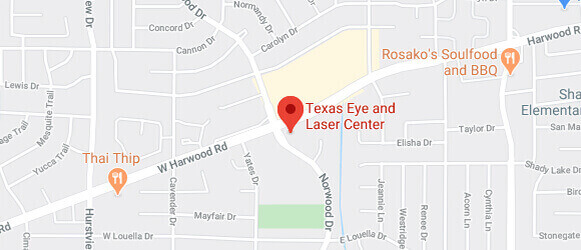To save you time during your visit, Texas Eye and Laser Center and Texas Eye Surgery Center offer our New Patient Forms online. Filling these out in advance of your first visit will minimize the time you spend in the waiting room when you get here.
If you’re not sure which forms you need, please contact us by calling 817-768-6620 for assistance.
New Patient Forms
For your convenience, Texas Eye & Laser Center has provided our New Patient Forms in a PDF and online version. If you prefer to print and bring your forms to the office, please choose the PRINTABLE PDF VERSION. If you would like to complete your patient forms online before your appointment, please choose the ONLINE FORM.
HIPAA Notice
PRINTABLE PDF VERSION ONLINE FORM
Medical Authorization Form
PRINTABLE PDF VERSION ONLINE FORM
Medical History Form
PRINTABLE PDF VERSION ONLINE FORM
Surgery Center Forms
If you are scheduled to have surgery at Texas Eye Surgery Center, please complete the following form(s) at your earliest convenience. Once complete – please send these forms electronically by emailing them to [email protected]!
- TESC-Medical History & Medicine List
- TESC-Pre-Op-Instructions (read prior to a nurse calling you)
- TESC-Medical Clearance for Surgery (if required)
Please feel free to learn about the various vision conditions listed below. If you think that you may be affected by one of these conditions, then do not hesitate to contact our office to arrange for an eye care appointment.
What are Cataracts?
Is your vision cloudy or blurry? Do pictures and colors appear dull or not sharp? Do your eyes hurt when you go out in the sun? If you answered YES to these questions, then you may be experiencing cataracts. A cataract is a clouding of the eye’s naturally clear lens. The lens typically becomes cloudy and has a bit of a yellowish hue to it. When the natural lens experiences this clouding effect, vision quality can be drastically diminished.
Many people describe this sensation as looking through a foggy car window or a piece of wax paper. Cataracts can be burdensome, especially to people who have had clear vision most of their life. For more information on cataracts, visit our Cataract Center page. Here you will find basic information on cataracts as well as the cataract surgery options we offer in Fort Worth & Hurst, TX. Are you seeking a cataract surgery expert? Call Texas Eye and Laser Center in Fort Worth, Texas, and Hurst, Texas.
What is Diabetic Retinopathy?
Anyone who has diabetes is at risk of developing diabetic retinopathy. The longer someone lives with diabetes, the greater the potential damage to the retina portion of the eye. At the initial onset of this condition, there may be little or no symptoms whatsoever. This is precisely why regular eye exams are critical for diabetics.
Diabetic retinopathy occurs in diabetics because of changes in the blood vessels in the back of the eye. When blood vessels in the retina are damaged, they may leak fluid or blood. The visual effect can blur or distort the images that the retina sends to the brain. The retina is a very sensitive part of the eye that transmits images through the optic nerve and then onto the brain. This complication of diabetes can cause blindness and is the leading cause of blindness for American adults.
If you are one of many untreated diabetics, then you are 25 times more likely to be at risk for developing diabetic retinopathy. According to the American Academy of Ophthalmology, about 80% of people who have diabetes develop some kind of damage to their retina. If you have diabetes and are concerned about diabetic retinopathy in the Dallas-Fort Worth area, then please call Texas Eye and Laser Center today for a thorough eye exam.
What is Dry Eye Syndrome?
Dry eye syndrome is caused by either a lack of tear production or poor tear quality. Tears are vital to the normal functions of the eye. Dry eye syndrome may develop for a wide variety of reasons, including environment, lack of enough drinking water, long term contact use, refractive surgery, and even antihistamines. This condition is actually quite common and increases in frequency with age.
The most common symptoms include pain from irritation, a “sandy feeling”, and lack of tolerance when wearing contact lenses. Intermittent excessive tearing can actually be a symptom as well. Treatment options for dry eye syndrome include over the counter lubricating drops, a medication called Restasis®, punctal plugs, and even Omega-3 Fish Oil supplements. For more information contact us directly.
What is Age-Related Macular Degeneration?
Age-related macular degeneration (AMD) is now the leading cause of vision loss among people over 65 in North America. The macula is the central portion of the retina, which is the light-sensitive tissue in the back of the eye. It is responsible for the sharp, central vision required for reading, driving, and seeing fine details. When the macula is affected by macular degeneration, the change may be abrupt and very noticeable. Since macular degeneration affects only the central vision, complete blindness does not typically occur.
In recent years, a number of medications and technologies have developed to combat AMD. VEGF-inhibiting medications can be used to treat wet-form AMD, which is a rapid-onset form of AMD. The CentraSight Implantable Miniature Telescope (IMT) is an implant designed to treat dry-form AMD, a gradual-onset form of AMD.
If you’ve noticed a change in your central vision and have any known risk factors (such as age over 65), then please allow Texas Eye and Laser Center to check your vision to prevent further loss of sight.
What is a Retinal Detachment
A retinal detachment occurs when the retina is pulled away from its normal position. The retina does not work when it is detached. Once the optic nerve is separated from the retina, there is no connection to transmit images to the brain. The vision then becomes very blurry for a patient in this condition. A retinal detachment is a very serious problem that almost always causes blindness unless it is treated. Retinal detachments occur alongside a large number of floaters, flashes, or shadows.
What are Floaters?
You may sometimes see small specks or clouds moving in your field of vision. They are called floaters. You can often see them when looking at a plain background, like a blank wall or blue sky. Floaters are actually tiny clumps of gel or cells inside the vitreous, the clear jelly-like fluid that fills the inside of your eye. Although the floaters appear to be in front of the eye, they are actually floating in the vitreous fluid inside the eye. What you see are the shadows they cast on the retina, the nerve layer at the back of the eye that senses light and allows you to see. Floaters can have different shapes: little dots, circles, lines, clouds, or cobwebs. If you are having the symptoms of flashes and floaters please contact Texas Eye and Laser Center to schedule an evaluation.
What is Glaucoma?
Glaucoma is an eye disease where the intraocular pressure in the eye increases and can eventually cause damage to the optic nerve, ultimately leading to vision loss if untreated. If you have a family history of glaucoma, then you should have a yearly checkup. With glaucoma, vision loss can occur with absolutely no warning signs or symptoms. The optic nerve is like a fine wire that connects the retina and the images we see to the brain.
Damage to the optic nerve can occur when the pressure within the eye increases, usually due to a build-up of aqueous fluid inside the eye. This leads to the development of blind spots in our field of vision. Glaucoma is a very serious disease that requires medical eye care attention. Vision loss caused by glaucoma is irreversible, but with medical attention, further vision loss can be avoided.
Glaucoma often goes undiagnosed because there is no pain associated with high intraocular pressure. Patients are urged to have routine eye exams to check the status of their general eye health. In a general eye exam, glaucoma tests can be performed, and the health of the eye’s retina can also be checked with a complete dilated eye exam.
According to the American Academy of Ophthalmology, approximately 2.2 million Americans age 40 and older have glaucoma.
What is Pink Eye?
Most people use the term “pink eye” to describe conjunctivitis. Conjunctivitis is swelling (inflammation) or infection of the membrane lining the eyelids as a result of various causes ranging from bacteria to parasites. Some causes may even be related to allergies. If you think you may have this eye inflammation, eye cleansing and eye drops can be effective for bacterial conjunctivitis. For more serious cases, patients will need to see an eye care professional. Be aware that conjunctivitis can be highly contagious.
What is Pterygium?
Pterygium is a benign, superficial, wing-shaped tissue growth that extends from the inner corner of the eye towards the pupil or the center of the eye. A pterygium may appear differently for different people. In general, a pterygium will range from an inconspicuous tissue mass to a large, red, and very noticeable growth. A pterygium may be yellow, gray, white, pink, red, or even colorless. It may have blood vessels. If you think you might be experiencing the growth of such tissue, please be sure to contact the Texas Eye and Laser Center for an immediate eye exam.
What is Uveitis?
Uveitis is inflammation of the inside of the eye (uvea). The uvea is the vascular layer of the eye in between the retina and the white part of the eye known as the sclera. The uvea extends toward the front of the eye and consists of the iris, the choroid layer, and the ciliary body. The most common type of uveitis is an inflammation of the iris called iritis. This eye condition can be very serious and can result in permanent vision loss. The doctors at Texas Eye and Laser Center strongly encourage early diagnosis and treatment to prevent complications.



